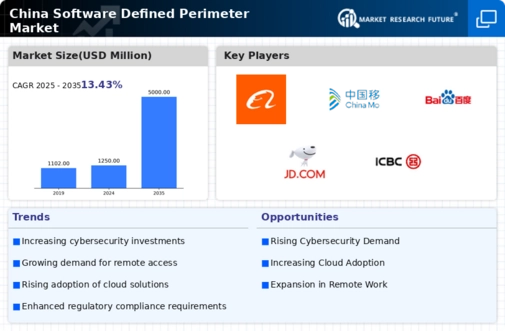Rising Cybersecurity Threats
The software defined-perimeter market in China is experiencing growth due to the increasing frequency and sophistication of cyber threats. As organizations face heightened risks from data breaches and ransomware attacks, there is a pressing need for advanced security solutions. The software defined-perimeter model offers a robust framework that enhances security by creating a secure perimeter around applications and data. According to recent estimates, the cybersecurity market in China is projected to reach $30 billion by 2025, indicating a strong demand for innovative security measures. This trend is likely to drive investments in software defined-perimeter technologies, as businesses seek to protect sensitive information and maintain compliance with regulatory standards. Consequently, the software defined-perimeter market is positioned to benefit from this escalating focus on cybersecurity.
Increased Remote Work Adoption
The shift towards remote work in China has created a pressing need for secure access to corporate resources, thereby driving the software defined-perimeter market. As more employees work from home or remote locations, organizations are challenged to maintain security while providing access to sensitive data. The software defined-perimeter model addresses these challenges by ensuring that only authenticated users can access specific resources, thereby minimizing the risk of unauthorized access. Recent surveys indicate that over 60% of companies in China plan to continue remote work policies post-pandemic, underscoring the need for secure remote access solutions. This trend is likely to fuel the adoption of software defined-perimeter technologies, as businesses seek to safeguard their networks in an increasingly remote work environment.
Growing Demand for IoT Security
The proliferation of Internet of Things (IoT) devices in China is significantly impacting the software defined-perimeter market. As IoT adoption accelerates across industries, the need for robust security measures to protect these interconnected devices becomes paramount. The software defined-perimeter model offers a comprehensive approach to securing IoT environments by establishing secure communication channels and access controls. With estimates suggesting that the number of IoT devices in China could exceed 1 billion by 2025, the demand for effective security solutions is likely to surge. This growing concern for IoT security is expected to drive investments in software defined-perimeter technologies, as organizations seek to mitigate risks associated with IoT vulnerabilities. Thus, the software defined-perimeter market is well-positioned to capitalize on the increasing focus on securing IoT ecosystems.
Digital Transformation Initiatives
The ongoing digital transformation across various sectors in China is a key driver for the software defined-perimeter market. As organizations transition to digital platforms, they face new security challenges that necessitate innovative solutions. The software defined-perimeter model provides a flexible and scalable approach to securing digital assets, making it an attractive option for businesses undergoing transformation. Reports indicate that the digital economy in China is expected to reach $4.5 trillion by 2025, highlighting the urgency for effective security measures. This rapid digitalization is likely to increase the demand for software defined-perimeter technologies, as companies seek to protect their digital infrastructure from emerging threats. Consequently, the software defined-perimeter market is poised for growth as organizations prioritize security in their digital transformation journeys.
Government Initiatives and Regulations
In China, government initiatives aimed at enhancing national cybersecurity are significantly influencing the software defined-perimeter market. The Chinese government has implemented various regulations that mandate stricter data protection measures across industries. For instance, the Cybersecurity Law of 2017 emphasizes the need for secure network infrastructure, which aligns with the principles of the software defined-perimeter model. As organizations strive to comply with these regulations, they are increasingly adopting software defined-perimeter solutions to ensure data security and privacy. This regulatory environment is expected to propel the market forward, as companies invest in technologies that align with government mandates. The software defined-perimeter market is thus likely to see substantial growth as compliance becomes a critical driver for technology adoption.
















Leave a Comment